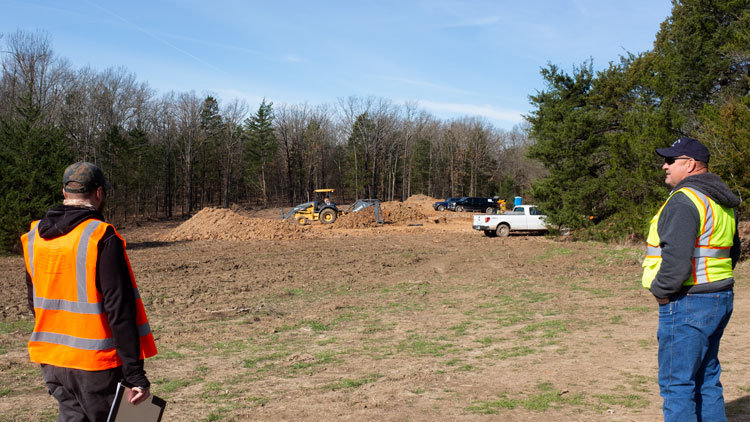On March 6, 2019, we return again to the Cemeteries. The work is complete at the Wilks site and the Bonham site is now yielding up its own set of surprises. The Bonham site holds not two graves, but twenty-three graves. Charity and Louisa Bonham have not been alone after all. We arrive in the early morning to an enormous work area from which twenty-one burials have been recovered. A recovery is underway under a pavilion, and one last burial shaft remains to be addressed.
Bonham site in early light, photo by Wanda Holmes Oliver.
The remains at the Bonham site are not as well preserved as the remains at the Wilks site, tending to be bone fragments rather than whole skeletons. The soil at the Wilks site is better drained and less acidic, and there was less damage there from the overgrowth of forest. As at the Wilks site, many of the burials are of infants and children. The graves, generally, are more shallow, and in one case an adult and two children were found in the same grave shaft. It is easy to read these as hasty burials and to speculate that perhaps they are the result of an overwhelming epidemic of some sort. The DNA work on these remains will be more difficult due to the deteriorated condition of the bodies, and we must hope that sufficient information can be retrieved to shed some light on these families. Some grave artifacts have been found, including ruby red beads, some buttons, and some pins. In one of the better preserved cases, the individual found is estimated to have been about 6’ 3” tall, unusually tall for the era.
The graves at the Bonham site are more randomly placed, but there is some organization along 6 irregular rows. Charity and Louisa are the westernmost burials. Then in a staggered row to the east of them are 4 graves, one to the north and three to the south. Continuing to move to the east, the next row has 4 graves - 2 at the northern end of the perimeter and 2 to the south beyond a sizable gap. The next row is the most regular with 8 burials in a line. The next row has 3 widely spaced graves, and the final row has one grave. The following schematic is illustrative, but not to scale.
For illustrative purposes only.
In the final count, 34 graves were recovered from the Wilks Cemetery, 23 from the Bonham Cemetery. Of 57 graves, 34 were unmarked. The 23 burials at the Bonham site included 8 adults, 3 juveniles/adults (could be teenagers or small adults), and 12 infants. At the Wilks site there were 13 adults, 9 juveniles, and 12 infants/toddlers. (These numbers are courtesy of AR Consultants and are based on what they observed in the field. They may change after they conduct their complete analysis.) Perhaps the biggest job is only just now beginning with the effort of trying to identify as many of the unknown remains as possible.
Emptied grave, Bonham Site, photo by Wanda Holmes Oliver.
Ginger documenting the Bonham Site, photo by Wanda Holmes Oliver.
Bonham Site, photo by Wanda Holmes Oliver.
After visiting the Bonham site, we walk down to the Wilks site. In the relentless march of time, it is no more. The Texas Historical Commission has been asked to release the site, and once this release is given, the clay soil found there will be harvested for use in building the dam.
Final view of the Wilks Cemetery, photo by Wanda Holmes Oliver.
Walking from the Wilks Site out towards what will be the basin of the lake, photo by Wanda Holmes Oliver.
Looking to the future, photo by Wanda Holmes Oliver.
The re-interment of the recovered remains will not begin for some months - not until the scientific work back in the lab is complete. So we leave our friends in Dr. Whitley’s capable hands with a whispered blessing. We will remember.
Wilks Cemetery as we knew it, photo by Wanda Holmes Oliver.
Bonham Family Cemetery, photo by Wanda Holmes Oliver.
Story by Wanda Holmes Oliver.










